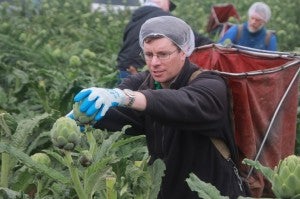California’s salad bowl tosses up new ideas in sustainability

I recently had the unique opportunity to learn firsthand how central California farmers are constantly changing the way specialty crops are grown, squeezing more from fewer resources and reducing their impacts on the environment.
I joined a handful of other ag policy experts in a visit to the Salinas Valley, considered “the salad bowl of the world,” where we learned about the current issues and complex challenges facing the state’s farmers and ranchers. The trip was organized by the California Agricultural Leadership Foundation.
Running about 90 miles from Monterey to San Luis Obispo, the Salinas Valley alone grows more than 85 percent of the nation’s artichokes, 55 percent of the nation’s lettuce and 30 percent of the nation’s strawberries. It also leads the state of California in the production of broccoli, celery, mushrooms and cabbage.
Rapid innovations
Most of the farms in the Salinas Valley are family-owned operations more than three generations deep, but that doesn’t mean these businesses stick with the tried and true. They are always looking for new ways to improve their efficiency and reduce their environmental footprint.
Many of the farming practices you would have seen as recently as five years ago have already changed. Here are a few examples of the innovations I witnessed during my trip:
- Saving energy: I met a vintner who was told he was crazy for putting windows and skylights in his winery – after all, light spoils wine. But all the fermentation happens in sealed tanks. By installing windows and skylights, he has reduced his energy use while improving the morale of employees working in the facility.
- More green: In the field I saw how growers of leafy greens are expanding the width of their rows from 40 to 60 inches – increasing yields per acre by 30 percent.
- Water efficiency: Growers in the Salinas Valley have long been concerned about their water use – they had the foresight to build waste-water recycling plants in the late 1990s. Today they are implementing subsurface drip irrigation for many vegetable and strawberry crops. This is critical as California enters what could become its fourth year of extreme drought.
- Pest control: Strawberry growers are working to eliminate the use of methyl bromide, typically used to fumigate the soil prior to planting. Use of this gas is gradually being phased out under the Montreal Protocol, but an alternative has been difficult to find for growing strawberries. Farmers in the Salinas Valley are investigating options such as using steam to control soil-borne pests and diseases. The preliminary results are encouraging – the outcome compared to methyl bromide is similar and the use of steam is not only kinder to the environment and field workers, it has been shown to double yields in some cases.
These examples of innovation in sustainability tell me that California’s farmers, who have historically been strong stewards of the environment, are continuing to lead by example – finding ways to reduce their environmental impacts while feeding the world.
It’s a good sign for the salad bowls of the future.












One Comment
Great article, I learned a great deal.
One question. Is that hairnet blue and gold?